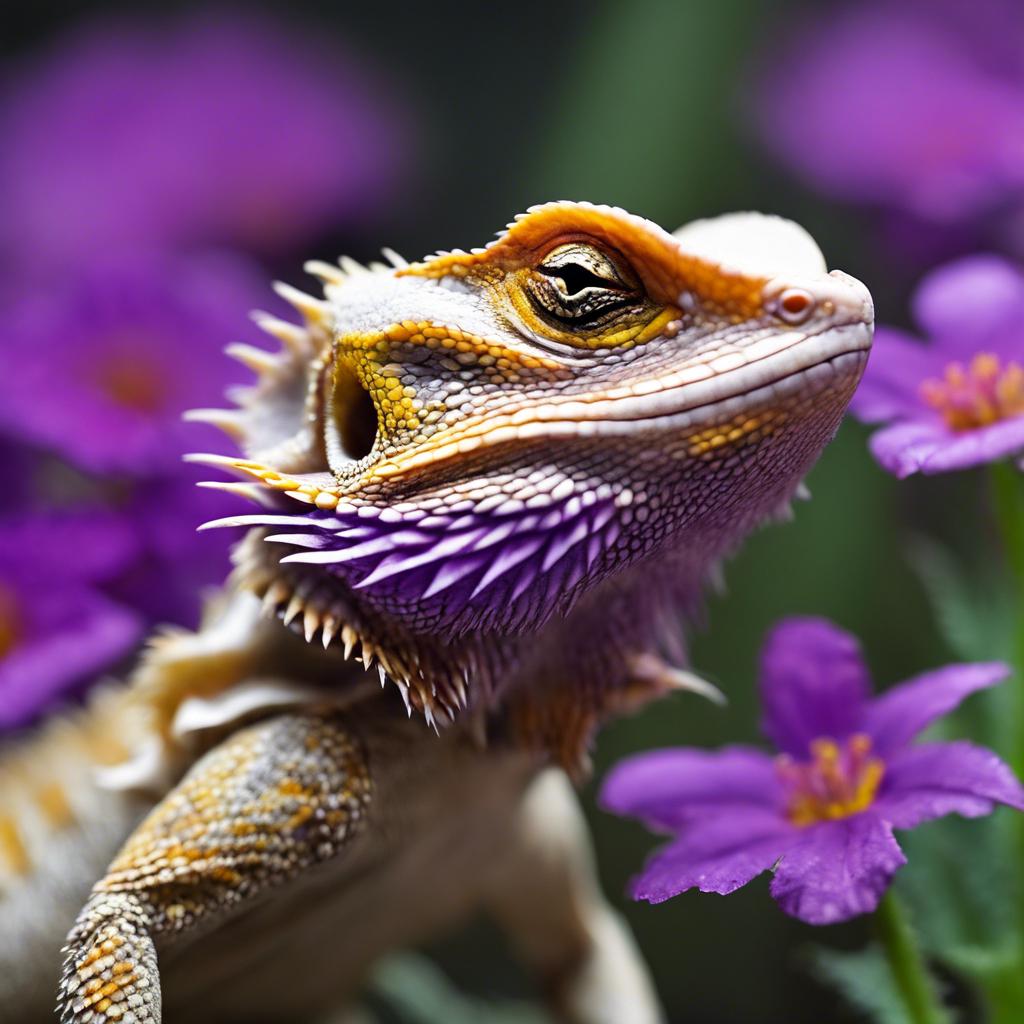Bearded dragons are popular reptile pets known for their unique appearance and docile nature. These lizards are native to Australia and have become increasingly popular as pets due to their low maintenance requirements and friendly demeanor. However, it is important to provide them with proper nutrition to ensure their overall health and well-being.
Proper nutrition is crucial for bearded dragons as it directly impacts their growth, development, and overall health. A balanced diet consisting of a variety of vegetables, fruits, and insects is essential for meeting their nutritional needs. In this article, we will explore the nutritional value of purple dead nettle for bearded dragons and discuss the risks and benefits of incorporating it into their diet.
Key Takeaways
- Bearded dragons are popular pets that require a balanced diet of vegetables, fruits, and insects.
- Purple dead nettle is a common weed that can be fed to bearded dragons in moderation.
- Purple dead nettle is high in calcium, iron, and vitamins A and C, making it a nutritious addition to a bearded dragon's diet.
- Feeding too much purple dead nettle can lead to digestive issues and potential toxicity, so it should be given in small amounts.
- Other safe vegetables and fruits for bearded dragons include collard greens, kale, squash, and blueberries. Regular vet check-ups and proper care are important for maintaining a healthy bearded dragon.
What is Purple Dead Nettle?
Purple dead nettle, also known as Lamium purpureum, is a flowering plant that belongs to the mint family. It is native to Europe and Asia but can now be found in various parts of North America as well. This plant is characterized by its vibrant purple flowers and soft, fuzzy leaves.
Purple dead nettle is often considered a weed due to its ability to grow rapidly in various environments. It can be found in gardens, lawns, fields, and even along roadsides. Despite being considered a weed, purple dead nettle has several uses for humans. It has been used in traditional medicine for its anti-inflammatory properties and is also consumed as a salad green or cooked vegetable.
Nutritional Value of Purple Dead Nettle for Bearded Dragons
Purple dead nettle is rich in vitamins and minerals that can benefit the health of bearded dragons. It contains high levels of vitamin C, which is essential for boosting their immune system and preventing diseases. Additionally, it is a good source of vitamin A, which promotes healthy vision and skin.
This plant also contains minerals such as calcium, phosphorus, and potassium, which are important for maintaining strong bones and muscles in bearded dragons. Calcium is especially crucial for these reptiles as it helps prevent metabolic bone disease, a common condition in captive reptiles.
Risks and Benefits of Feeding Purple Dead Nettle to Bearded Dragons
While purple dead nettle can provide several nutritional benefits to bearded dragons, there are also potential risks associated with feeding it to them. One of the main concerns is the presence of oxalates in this plant. Oxalates can bind to calcium and form crystals, which can lead to the development of kidney stones in bearded dragons.
To mitigate this risk, it is important to feed purple dead nettle in moderation and ensure that the diet is well-balanced with other calcium-rich foods. It is also recommended to provide a variety of vegetables and fruits to ensure that the bearded dragon receives a wide range of nutrients.
Despite the potential risks, incorporating purple dead nettle into a bearded dragon's diet can have several benefits. The high vitamin and mineral content can contribute to their overall health and well-being. However, it is important to consult with a veterinarian or reptile nutritionist before introducing any new food into their diet.
How to Prepare Purple Dead Nettle for Bearded Dragons
Before feeding purple dead nettle to bearded dragons, it is important to properly prepare it to ensure its safety for consumption. Here are step-by-step instructions for preparing purple dead nettle for bearded dragons:
1. Harvest fresh purple dead nettle leaves from a clean and pesticide-free area.
2. Rinse the leaves thoroughly under running water to remove any dirt or debris.
3. Remove any wilted or discolored leaves.
4. Chop the leaves into small, bite-sized pieces.
5. Steam or blanch the leaves for a few minutes to soften them.
6. Allow the leaves to cool completely before serving them to your bearded dragon.
It is important to note that only the leaves of purple dead nettle should be fed to bearded dragons. The flowers and stems can be toxic and should be avoided.
How Much Purple Dead Nettle Should Bearded Dragons Eat?

The recommended serving size of purple dead nettle for bearded dragons depends on their age, size, and overall health. As a general guideline, it is recommended to feed them a small amount of purple dead nettle once or twice a week. This should be supplemented with a variety of other vegetables, fruits, and insects to ensure a well-balanced diet.
It is important to monitor the bearded dragon's response to the purple dead nettle and adjust the serving size accordingly. If any digestive issues or changes in behavior occur, it is best to consult with a veterinarian.
Other Safe Vegetables and Fruits for Bearded Dragons
In addition to purple dead nettle, there are several other safe vegetables and fruits that can be included in a bearded dragon's diet. Some examples include:
– Leafy greens: kale, collard greens, mustard greens, dandelion greens
– Squash: butternut squash, acorn squash, zucchini
– Bell peppers
– Carrots
– Blueberries
– Apples
It is important to provide a variety of foods to ensure that the bearded dragon receives a wide range of nutrients. This can help prevent nutritional deficiencies and promote overall health.
Bearded Dragon Care Tips
Proper care is essential for the health and well-being of bearded dragons. Here are some general care tips to keep in mind:
1. Provide a spacious enclosure with appropriate temperature gradients and lighting.
2. Offer a balanced diet consisting of vegetables, fruits, and insects.
3. Ensure access to clean water at all times.
4. Regularly clean the enclosure to maintain hygiene.
5. Handle the bearded dragon gently and avoid excessive stress.
6. Provide opportunities for exercise and mental stimulation.
7. Schedule regular vet check-ups to monitor their health.
Signs of Illness in Bearded Dragons
It is important to be aware of the common signs of illness in bearded dragons to ensure prompt veterinary care. Some signs to watch out for include:
– Loss of appetite
– Weight loss
– Lethargy or weakness
– Changes in behavior or temperament
– Abnormal bowel movements
– Respiratory issues (e.g., wheezing, difficulty breathing)
– Swollen or discolored skin
If you suspect that your bearded dragon is sick, it is best to consult with a veterinarian who specializes in reptile care. They can provide a proper diagnosis and recommend appropriate treatment options.
Can Bearded Dragons Eat Purple Dead Nettle?
In conclusion, purple dead nettle can provide several nutritional benefits to bearded dragons. It is rich in vitamins and minerals that contribute to their overall health and well-being. However, it is important to feed purple dead nettle in moderation and ensure a well-balanced diet with other calcium-rich foods.
While there are potential risks associated with feeding purple dead nettle to bearded dragons, these risks can be mitigated by following proper preparation techniques and consulting with a veterinarian or reptile nutritionist. Ultimately, the decision to feed purple dead nettle to bearded dragons should be made based on individual circumstances and the advice of a professional.
If you're wondering whether bearded dragons can eat purple dead nettle, you may also be interested in learning about the potential dangers of stress for these reptiles. Stress can have serious consequences for bearded dragons, and it's important to understand how to prevent and manage it. To learn more about this topic, check out this informative article on Reptile Wizard: Can Bearded Dragons Die from Stress?
FAQs
What is purple dead nettle?
Purple dead nettle is a type of flowering plant that belongs to the mint family. It is also known as Lamium purpureum and is commonly found in North America and Europe.
Is purple dead nettle safe for bearded dragons to eat?
Yes, purple dead nettle is safe for bearded dragons to eat in moderation. It is a good source of fiber and nutrients such as calcium and vitamin A.
Can bearded dragons eat purple dead nettle leaves and flowers?
Yes, bearded dragons can eat both the leaves and flowers of purple dead nettle. However, it is important to wash them thoroughly before feeding them to your pet.
How often can bearded dragons eat purple dead nettle?
Bearded dragons can eat purple dead nettle as a part of their diet once or twice a week. It should not be the main source of their diet and should be fed in moderation.
What are the benefits of feeding purple dead nettle to bearded dragons?
Purple dead nettle is a good source of fiber, calcium, and vitamin A, which are essential for the health of bearded dragons. It can also help with digestion and prevent constipation.
Are there any risks associated with feeding purple dead nettle to bearded dragons?
Feeding too much purple dead nettle to bearded dragons can cause digestive problems such as diarrhea. It is important to feed it in moderation and as a part of a balanced diet.

